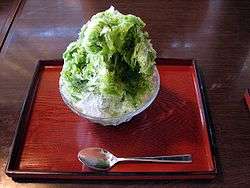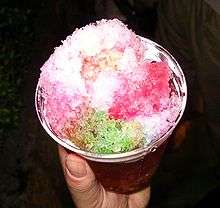Kakigōri
 Kakigōri with green tea flavor | |
| Type | Shaved ice |
|---|---|
| Course | Dessert |
| Place of origin | Japan |
| Main ingredients | Ice, syrup, condensed milk or evaporated milk |
| Variations | Shirokuma |

Kakigōri (かき氷) is a Japanese shaved ice dessert flavored with syrup and a sweetener, often condensed milk.[1]
History
The origins of kakigōri date back to the 11th century, when blocks of ice saved during the colder months would be shaved and served with sweet syrup to Japanese aristocracy during the summer. Kakigōri became more accessible in the 19th century, when ice became more widely available to the public during the summertime.[2]
Description
The traditional way of making kakigōri uses a hand cranked machine to spin a block of ice over a shaving blade.[3][2] Even though electric shavers are most often used, street vendors can still be seen hand-shaving ice blocks in the summer.
It is similar to a snow cone but with some notable differences: It has a much smoother fluffier ice consistency, much like fresh fallen snow, and a spoon is almost always used to eat it. The texture of the ice distinguishes kakigōri from other types of shaved ice desserts.[3]
Popular flavors include strawberry, cherry, lemon, green tea, grape, melon, "Blue Hawaii", sweet plum, and colorless syrup. Some shops provide colorful varieties by using two or more syrups. To sweeten kakigōri, condensed or evaporated milk is often poured on top of it.
In addition to the streets, kakigōri is sold in festivals, convenience stores, coffee shops, and restaurants. During the hot summer months, kakigōri is sold virtually everywhere in Japan. Especially at summer festivals and fairs, it is as popular as yakisoba, takoyaki and cotton candy. Kakigôri is one of the summer features in Japan. Some shops serve it with ice cream and sweetened red beans or tapioca pearls.
Shirokuma
 | |
| Type | Kakigōri |
|---|---|
| Course | Dessert |
| Place of origin | Japan |
| Region or state | Kagoshima prefecture |
| Main ingredients | Ice, condensed milk |
Shirokuma (白熊 or しろくま) is a type of kakigōri, a Japanese dessert made from shaved ice flavored with condensed milk, small colorful mochi, fruits, and sweet bean paste (usually Azuki bean). Mandarin orange, cherry, pineapple, and raisins are often used to make shirokuma.
Description
Shirokuma has been popular in Kagoshima since the middle of the Edo period and is well-known to many Japanese. Condensed milk, fruit, and sweet bean paste are served over shaved ice. It is eaten in cafés and in some department stores, such as Yamakataya (山形屋) or Mujaki.
Etymology
Shirokuma literally means "white bear" and indicates "polar bear" in Japanese. There are some views about the origin of the name.
In one account, there was a cotton shop in Kagoshima city. The shop started to sell kakigōri as its side-business. The kakigōri was flavored with condensed milk. When the owner was thinking of a name for it, he noticed the picture of a polar bear was printed on the labels of the condensed milk's can.
Another account is that Mujaki, a coffee shop in Kagoshima City, started to sell the kakigōri, put milk syrup, sanshoku-kanten (colorful agar), yōkan (soft azuki-bean jelly), sweet beans and fruits in a pattern that resembled a polar bear when seen from overhead, so it was named shirokuma.
Yet others say that it was created in honour of the memory of Saigo Takamori after his battle with the Edo Shogun.
In Kagoshima, some similar named kakigōri are made. Kurokuma flavored with dark brown unrefined sugar syrup, coffee or caramel syrup and kiguma flavored with mango pulp syrup are made in some coffee shops.
Availability
Supermarkets in southern Kyushu, especially in Kagoshima City, Kagoshima, and mom-and-pop candy stores sell shirokuma as a popular product. Shirokuma are often eaten at Kagoshima fairs which are held in other prefectures. Shirokuma in cups are sold at convenience stores all over Japan.
See also
Similar dishes in other cultures
- Baobing: a Chinese shaved ice
- Patbingsu: a Korean shaved ice
- Halo-halo: a Philippine shaved ice
- Es campur: an Indonesian shaved ice
- Es teler: an Indonesian shaved ice
- Ais Kacang (ABC): a Malaysian shaved ice
- Grattachecca: an Italian shaved ice popular in Rome.
- Hawaiian shave ice: a Hawaiian shaved ice
References
- ↑ 新明解国語辞典(第6版)、三省堂
- 1 2 Krishna, Priya (March 15, 2018), "Kakigori Is an Ancient Frozen Japanese Specialty – Now It's America's Hottest Dessert, Too", Grub Street
- 1 2 Rao, Tejol (September 17, 2018), "An Avalanche of Japanese Shave Ice", The New York Times
External links
| Wikimedia Commons has media related to Shirokuma. |
- 天文館むじゃき (Japanese)
- かごしま遊楽館 (Japanese)
- セイカ食品株式会社:南国白くま (Japanese)
- 鹿児島 山形屋 (Japanese)
- You can eat a polar bear in Kagoshima Rocket NEWS 24 (English)